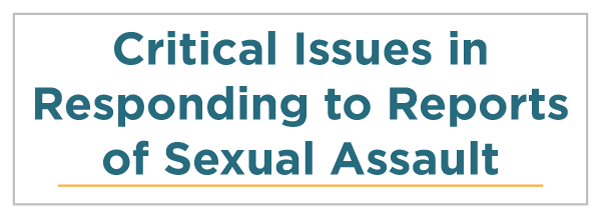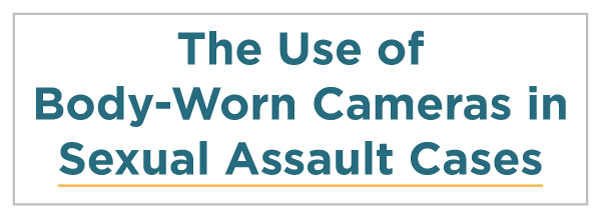
 |
 |
 |
 |
 |
 |
 |
 |
 |
 |
 |
 |
 |
 |
 |
Police departments across the country are increasing the use of body-worn cameras (BWCs) to record interactions between police officers and the public. [67] Typically mounted to a police officer’s head or chest, a BWC is a camera equipped with one or more microphones, a battery, and data storage for audio and video footage.
In 2015, the Office of Justice Programs at the U.S. Department of Justice awarded funding to 73 local and tribal agencies in 32 states to expand use of BWCs and explore their impact. [68] As of late 2016, over 60 types of BWCs were available for law enforcement use. [69]
“With these abilities [technological advances] comes the tremendous responsibility to thoughtfully and respectfully balance the privacy rights of citizens and victim autonomy with the mission to serve and protect communities.” Deliberations from the International Association of Chiefs of Police (IACP) National Forum on Body-Worn Cameras and Violence Against Women
When expanding the use of technology, particularly BWCs, it is critical to carefully examine the benefits and potential impact while developing policies and programs. [70] As this is an emerging area of practice, where “no one-size-fits-all policy or program for the use of body-worn cameras exists,” [71] it is crucial that departments continually evaluate and respond to emerging best practices regarding how to use BWCs in a responsible and ethical manner that includes collaboration between the community and criminal justice partners.
The IACP recommends consistent, reoccurring, and effective training for agency personnel to develop and support victim-centered programs. This standard should be central in assessing the effectiveness of BWCs in responding to sexual assault.
Respecting the right to privacy, promoting safety, and enhancing victim autonomy must be critical components of any considerations or policy discussions on the use of BWCs, particularly when investigating sexual assault crimes. BWCs may capture crime scene footage, preserve victim and suspect accounts of what occurred, capture victim and suspect experiences and post-assault behaviors, and provide compelling evidence for judges and juries during sex crime prosecutions.
BWCs can record information about a victim’s identity and whereabouts, which could potentially jeopardize a victim’s safety if the perpetrator views the recording, if recorded data is handled improperly, or if that recording becomes public record. Often sexual assault takes place in areas where the expectation of privacy is high, such as a home or school, and a BWC may be seen as especially invasive in these locations. [72] The impact of BWCs on decisions to report to law enforcement is unknown, [73] but they may affect a victim’s ability or willingness to speak to police. It is unknown at this time if BWCs support victims in feeling empowered.
Video recordings —
However, video recordings of victim interviews may create issues of concern due to incomplete or inconsistent statements and misunderstanding of the demeanor of the victim. Using trauma-informed interview processes may significantly reduce these potential issues.
The rate at which police officers around the United States activate BWCs during sex crime investigations is unknown. The studies that have been done about use of BWCs highlight the need for ongoing research and evaluation into the use of BWCs during investigations of sexual assaults.
SARTs can be part of gathering and sharing feedback received from victims on BWCs. Information received from one discipline may be useful to the decisions of another discipline. [74] SART meetings may be a useful location to share information that impacts multiple disciplines to increase the overall system response.
Police departments should consider ways BWC activation can affect victim cooperation in sexual assault cases, especially intimate partner sexual assault cases. For example, victims of intimate partner sexual assault, as a result of fear for their safety, may downplay their victimization or refrain from reporting victimization to the police as a means of protecting themselves from additional abuse.
Other victims may appreciate only having to share their experience once. When BWCs capture sexual assault victims’ behaviors [75] that are misinterpreted by law enforcement and criminal justice professionals, it will likely affect a victim’s willingness or ability to stay involved in the investigation and prosecution of their case. This misinterpretation can be mitigated by educating criminal justice professionals on trauma-informed response, neurobiology of trauma, trauma reactions, and trauma memory.
In general, policies around BWC activation should consider their use in private spaces and compatibility with other legal requirements, such as the Health Insurance Portability and Accountability Act (HIPAA); school policies that prohibit filming or recording children; and other state, local, federal, and tribal laws. [76]
Policies around activation should clearly require officers to consider and respect a victim’s ability to make informed choices, including direct language such as, “‘informed consent must be obtained’ rather than ‘consideration must be given to victims and victim safety.’” [77]
Research suggests that members of the public have a generally positive opinion of BWCs and that police use of BWCs can help foster good community relations.
A 2015 study of Florida residents found that the majority of respondents did not see BWCs as an invasion of residents’ privacy or police officers’ privacy. Furthermore, most respondents believed that BWCs would help police gather quality evidence (88.5 percent), improve public perceptions of police legitimacy (77.6 percent), improve resident behavior during interactions with police (79.4 percent), and improve police officer behavior during interactions with residents (87.1 percent). [78]
Another study found that a national sample of respondents were generally supportive of BWCs, believing they would improve evidence gathering in criminal incidents, promote transparency, and encourage police to behave more respectfully to citizens, suspects, and crime victims. [79] However, whether members of the public hold the same opinions about the use of BWCs in sexual assault cases is not known. Additional research is needed on community and victim opinions of BWCs in these cases, as well as the impact of BWCs on victims of sexual assault.
Additional research is needed to gauge the impact of BWCs on sexual assault case outcomes. While one study found that the use of BWCs increased the likelihood of charges being filed in intimate partner violence cases, it is unknown if BWCs would produce similar outcomes in sex crime cases. [80] As this is an emerging area, SARTs are encouraged to be knowledgeable about the current practices in their jurisdiction, including any rights victims have regarding use of a BWCs. SARTs may also provide critical feedback to inform emerging policies related to BWCs.
As BWC use becomes increasingly prevalent among first-responder police officers, SARTs and law enforcement departments should address the use of BWCs during sex assault cases in their written policies. Policies should discuss protocols for BWC use during cases of sexual assault, child sexual abuse, and sex trafficking to gather evidence and protect the rights and safety of victims.
SARTs and police departments should reflect on the unique nature of sexual assault crimes when creating BWC protocol and consider the following questions:
Audio, video, and metadata information captured by BWCs contain identifying and sensitive information about sexual assault victims. Thus, access to BWC data must be secure and regulated. Police departments should limit access to BWC data from sexual assault cases to necessary personnel and develop policies regarding prohibited use of BWC data. [81]
As with the implementation of any technology, police departments should ask: Is it private, is it safe, what if it does not work, and what are the possible unintended outcomes? For example, defendants may have access to the tapes at trial, especially if the defendant is acting as their own attorney. Are there protections in place to ensure the information on the tapes is not shared in a way that could further harm the victim?
Police departments should also review policies and protocols related to Freedom of Information Act (FOIA) requests for BWC data, especially as they relate to sex crimes. The FOIA states that public records must be made available to the public upon request, but exceptions to FOIA limit what materials can be given to the public (e.g., material that is part of an ongoing investigation, that could violate privacy, or that could harm an individual). [82]
Deliberations from the International Chiefs of Police National Forum on Body-Worn Cameras and Violence Against Women (PDF, 60 pages)
The information in this report was compiled from multidisciplinary conversations at the IACP National Forum held February 2106. This report provides a comprehensive report on recommendations and concerns related to the use of BWCs.
Police Body Cameras in Domestic and Sexual Assault Investigations: Considerations and Unanswered Questions (PDF, 13 pages)
Developed by Battered Women’s Justice Project, “this paper identifies and addresses the various issues — those known and unresolved — that may arise when law enforcement personnel equipped with body cameras respond to victims of domestic violence and sexual assault, including issues of privacy and confidentiality, witness intimidation, possible evidentiary challenges when using body camera footage in trial, and unintended consequences such access and use may create for victims.” [83]
To Record or Not to Record: Use of Body-Worn Cameras During Police Response to Crimes of Violence Against Women (PDF, 6 pages)
This brief from Aequitas discusses the pros and cons of BWCs use as well as policy considerations.
| Back | Index | Next |
